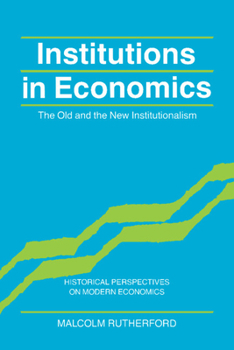Institutions in Economics: The Old and the New Institutionalism
(Part of the Historical Perspectives on Modern Economics Series)
Select Format
Select Condition 
Book Overview
This book examines and compares the two major traditions of thought that have attempted to incorporate institutions within economics. These are the Old (or American) Institutionalist tradition of Veblen, Mitchell, Commons and Ayres, and the New Institutionalism that has developed more recently from neoclassical and Austrian sources. The discussion is organized around a set of key problems involving the use of formal or nonformal analytical methods, individualist or holistic approaches, the respective roles of rational choice and rule following behavior, the relative importance of spontaneous evolution and deliberative design of institutions, and questions relating to the normative appraisal of institutions.
Format:Hardcover
Language:English
ISBN:0521451892
ISBN13:9780521451895
Release Date:March 1994
Publisher:Cambridge University Press
Length:240 Pages
Weight:1.14 lbs.
Dimensions:0.8" x 6.3" x 9.3"
Customer Reviews
2 ratings
Institutionalism compared: old vs. new
Published by Thriftbooks.com User , 17 years ago
This little book packs a lot of punch. The author is very clear in the beginning that his purpose in this book is to explicate the similarities (complementarities) and differences (areas of conflict)between the Old Institutionalist Economics (OIE) and the New Institutionalist Economics (NIE). I think it was wise to approach this work thematically rather than chronologically, although in each chapter the OIE are always mentioned first. The author is very fair to both sides (though if I had to guess, I would say his sympathies rest with the OIE), and the reader can find himself agreeing with arguments on both sides. However, the book does seem to move at a quick pace. Because of this, I have had trouble trying to organize (and memorize) all of the different arguments and positions on both sides. There is a lot contained in this little book, and for that reason anyone interested in this subject is seriously encouraged to pick it up. But I would also recommend that the prospective reader familiarize himself with some other literature in institutional economics along the lines of North, Coase, Williamson, Geoffrey Hodgson, and Eggertsson. This book is a sort of survey work covering the field of institutional economics, both old and new. The theme of the book is that one can find points of similarity and conflict in both schools, and that it is incorrect to characterize OIE and NIE as representing two opposite extremes.
A great introduction to and comparison of old and new instit
Published by Thriftbooks.com User , 26 years ago
A very useful book. Rutherford categorizes the two schools of institutional thought, surveys the thought in each school, addresses the key differences between the two schools of thought on issues such as abstraction vs realism, formalism vs qualitative analysis, etc.For anyone who doesn't already know, old institutionalism started off as a reaction against the lack of realism and awareness of historical evolutionary processes in Neoclassical economics. It was therefore sharply opposed to Neoclassical thought. New institutional thought is an extension of the neoclassical framework, still operating on the assumptions of (bounded) rationality and utility or profit maximization, to the analysis of institutions. There is therefore a significant tension between old and new institutionalists, with old institutionalists attacking many of the assumptions inherent in the new institutional approach which are still essentially imported from neoclassical economics. Both the old institutionalists and the new institutionalists see the new institutional economics as a progress forward: the old institutionalist just dont believe the new institutionalists have gone far enough. They are probably right!






